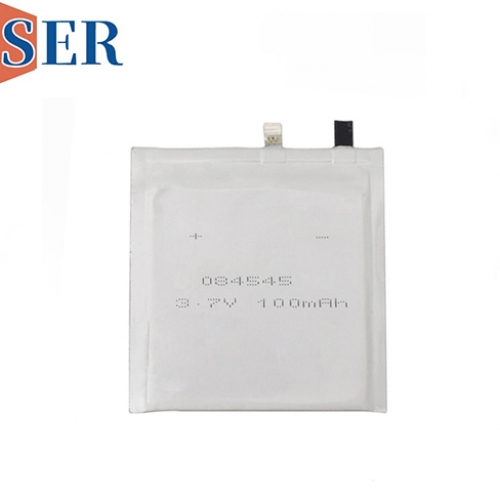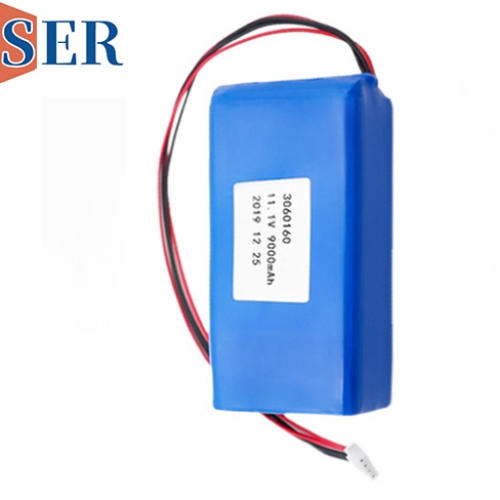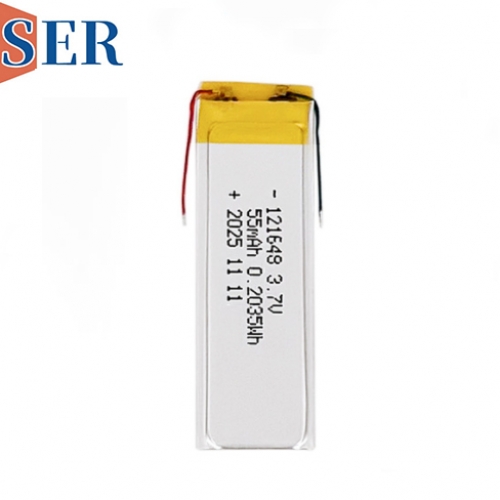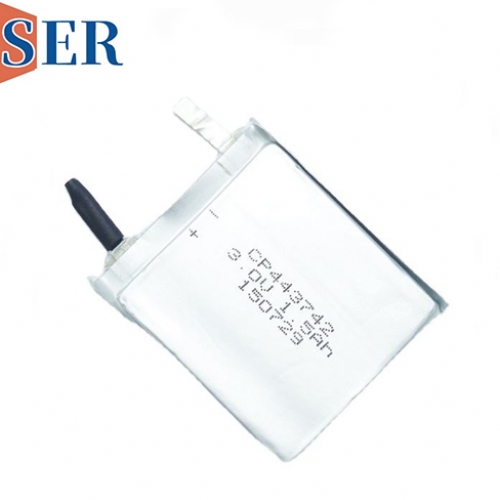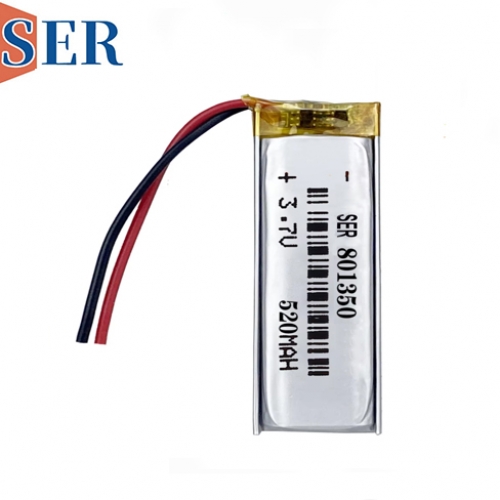CP401725 3.0V 280mAh LiMnO₂ Pouch Cell: A Revolution in Ultra-Thin, High-Energy Primary Batteries
CP401725 3.0V 280mAh LiMnO₂ Pouch Cell: A Revolution in Ultra-Thin, High-Energy Primary Batteries

Abstract
The evolution of portable electronics, medical devices, and Internet of Things (IoT) sensors has necessitated the development of compact, lightweight, and high-energy-density power sources. Among these advancements, the CP401725 3.0V 280mAh lithium manganese dioxide (LiMnO₂) pouch cell stands out as a primary ultra-thin battery, offering a blend of high voltage, energy density, and long shelf life. This article explores the unique characteristics, benefits, and applications of the CP401725 LiMnO₂ pouch cell, emphasizing its suitability for custom designs, instant usability, and maintenance-free operation. With a nominal voltage of 3.0V, energy density exceeding 450 Wh/kg, and a self-discharge rate of less than 1% per year at room temperature, this battery technology is poised to redefine the landscape of ultra-thin power solutions.
Introduction
In the era of miniaturization and connectivity, the demand for compact, reliable, and high-performance batteries has surged. Traditional battery forms, such as cylindrical or prismatic cells, often struggle to meet the stringent size and weight constraints of modern electronic devices. The CP401725 LiMnO₂ pouch cell addresses this challenge by offering a flexible, ultra-thin format that can be tailored to fit a wide range of applications. As a primary battery, it provides a consistent and reliable power source without the need for recharging, making it ideal for devices with intermittent or low-power usage patterns.
Understanding the CP401725 LiMnO₂ Pouch Cell
1. Chemistry and Construction
The CP401725 battery employs a lithium manganese dioxide (LiMnO₂) chemistry, known for its high voltage output and stability. In this configuration, lithium serves as the anode, while manganese dioxide (MnO₂) acts as the cathode. The electrolyte, typically a lithium salt dissolved in an organic solvent, facilitates ion movement between the electrodes during discharge. The pouch cell format, characterized by a flexible, laminated outer casing, allows for customizable shapes and sizes, making it highly adaptable to various device designs.
2. Key Specifications
Nominal Voltage: 3.0V
Capacity: 280mAh
Energy Density: Up to 450 Wh/kg
Self-Discharge Rate: Less than 1% per year at room temperature
Operating Temperature Range: Typically -20℃ to +60℃ (may vary based on manufacturer specifications)
Form Factor: Ultra-thin pouch cell, customizable dimensions
3. No Passivation Effect
One of the standout features of the CP401725 LiMnO₂ pouch cell is its immunity to passivation. Passivation occurs when a protective layer forms on the electrodes, increasing internal resistance and reducing voltage output over time. In traditional lithium batteries, this can lead to performance degradation and shortened lifespan. The CP401725's chemistry and design mitigate this effect, ensuring consistent voltage delivery and immediate usability upon installation.
Advantages of the CP401725 LiMnO₂ Pouch Cell
1. High Voltage Output
With a nominal voltage of 3.0V, the CP401725 battery provides a higher voltage than many alternative primary battery chemistries, such as alkaline or zinc-air batteries. This higher voltage allows for more efficient power delivery, enabling devices to operate at optimal performance levels without the need for voltage regulation circuits in many cases. Additionally, the stable voltage output over the discharge cycle ensures consistent device functionality until the battery is depleted.
2. Exceptional Energy Density
Energy density is a critical metric in battery technology, representing the amount of energy stored per unit mass. The CP401725 battery boasts an energy density of up to 450 Wh/kg, significantly higher than many traditional battery types. This high energy density translates to longer runtime in compact devices, making it ideal for applications where space and weight are at a premium. Whether powering a medical implant, a wearable sensor, or a remote monitoring device, the CP401725 battery ensures reliable operation without excessive bulk.
3. Long Shelf Life and Low Self-Discharge
The self-discharge rate of a battery refers to the gradual loss of charge when the battery is not in use. The CP401725 LiMnO₂ pouch cell exhibits a remarkably low self-discharge rate of less than 1% per year at room temperature. This characteristic ensures that the battery retains its charge for extended periods, making it suitable for devices with infrequent usage or long storage intervals. Manufacturers can stockpile batteries without significant capacity loss, and end-users can rely on the battery's performance even after prolonged periods of inactivity.
4. Customizable and Ultra-Thin Form Factor
The pouch cell format of the CP401725 battery offers unparalleled flexibility in design. Manufacturers can customize the battery's shape, size, and thickness to fit specific device requirements, whether it's a credit card-sized medical patch, a slim wearable device, or a compact IoT sensor. This adaptability eliminates the need for bulky battery compartments or complex mechanical designs, enabling sleeker, more efficient product form factors.
5. Instant Install-and-Use
Unlike some battery technologies that require initial charging or activation, the CP401725 LiMnO₂ pouch cell is ready for immediate use upon installation. This "install-and-use" feature simplifies the device assembly process and reduces time-to-market for manufacturers. End-users benefit from hassle-free operation, as there's no need for pre-charging or conditioning the battery before use.
6. Maintenance-Free Operation
As a primary battery, the CP401725 does not require recharging or maintenance during its operational life. Once depleted, it can be safely disposed of or recycled according to local regulations. This maintenance-free operation reduces the complexity and cost associated with battery management systems, making it an attractive choice for cost-sensitive applications.
Applications of the CP401725 LiMnO₂ Pouch Cell
1. Medical Devices
The CP401725 battery's high voltage, energy density, and customizable form factor make it an ideal power source for medical devices, including:
Wearable Health Monitors: Devices such as continuous glucose monitors (CGMs), electrocardiogram (ECG) patches, and pulse oximeters require compact, reliable batteries to track vital signs over extended periods.
Implantable Medical Devices: Certain implantable devices, such as neurostimulators or drug delivery pumps, benefit from the battery's long shelf life and stable voltage output, ensuring consistent therapy delivery.
Portable Diagnostic Tools: Handheld ultrasound devices, blood analyzers, and other diagnostic tools rely on high-energy-density batteries to support on-the-go testing and diagnostics.
2. Wearable Electronics
The rise of wearable technology, including smartwatches, fitness trackers, and augmented reality (AR) glasses, has driven the demand for ultra-thin, high-performance batteries. The CP401725 battery's flexibility and energy density enable:
Slim Form Factors: Devices can be designed with minimal thickness, enhancing comfort and aesthetics.
Extended Runtime: Despite their small size, wearables can operate for days or even weeks on a single charge, depending on usage patterns.
Customizable Designs: Manufacturers can integrate the battery seamlessly into the device's chassis, optimizing space utilization.
3. IoT and Sensor Networks
The Internet of Things (IoT) relies on a vast network of connected sensors to collect and transmit data. The CP401725 battery is well-suited for powering IoT sensors in applications such as:
Environmental Monitoring: Sensors tracking temperature, humidity, air quality, or water levels require long-lasting, reliable power sources.
Asset Tracking: GPS trackers, RFID tags, and other asset management devices benefit from the battery's high energy density and low self-discharge, ensuring continuous operation over extended periods.
Smart Infrastructure: Sensors embedded in buildings, bridges, or utilities networks rely on the battery's stability and longevity to provide real-time data for maintenance and optimization.
4. Consumer Electronics
From electronic toys to remote controls, the CP401725 battery offers a compact, high-performance power solution for consumer electronics. Its customizable form factor allows manufacturers to design sleeker, more innovative products, while its long shelf life ensures that devices remain ready for use even after prolonged storage.
5. Industrial and Automotive Applications
In industrial settings, the CP401725 battery can power wireless sensors, monitoring equipment, or portable tools. In automotive applications, it may be used in key fobs, tire pressure monitoring systems (TPMS), or other low-power accessories, offering reliable performance in challenging environments.
Design Considerations for CP401725 Integration
1. Thermal Management
While the CP401725 battery operates efficiently across a wide temperature range, effective thermal management is crucial to ensure optimal performance and longevity. Manufacturers should design devices to dissipate heat effectively, especially during high-current operations or in environments with extreme temperatures. This may involve incorporating heat sinks, thermal pads, or optimizing the device's airflow.
2. Mechanical Protection
The pouch cell format of the CP401725 battery is relatively flexible but requires mechanical protection to prevent damage from physical stressors such as bending, crushing, or puncturing. Manufacturers should design battery compartments or enclosures that shield the battery from external forces while maintaining its flexibility and form factor.
3. Electrical Integration
Proper electrical integration is essential to ensure safe and efficient battery operation. This includes selecting appropriate connectors, circuit protection components (such as fuses or current-limiting resistors), and ensuring compliance with relevant safety standards. Additionally, manufacturers should consider the battery's discharge characteristics and design the device's power management circuits accordingly.
4. Environmental Considerations
The CP401725 battery, like all lithium-based batteries, requires proper disposal or recycling at the end of its life cycle. Manufacturers should design devices with easy battery replacement or recycling in mind, providing clear instructions to end-users and adhering to local environmental regulations.
Future Prospects and Innovations
The field of primary battery technology is continually evolving, driven by advancements in materials science, manufacturing processes, and the increasing demand for compact, high-performance power sources. Future innovations in LiMnO₂ pouch cell technology may include:
1. Enhanced Energy Density
Ongoing research into electrode materials and electrolyte formulations may lead to further increases in energy density, enabling even longer runtimes in smaller packages. This could open new applications for ultra-thin batteries in areas such as advanced medical implants or miniature drones.
2. Improved Safety Features
While the CP401725 battery is inherently safe, future iterations may incorporate additional safety features, such as built-in overcharge/overdischarge protection or thermal shutdown mechanisms. These enhancements would further reduce the risk of accidents and increase user confidence.
3. Sustainable Materials and Manufacturing
As environmental concerns grow, there's a push toward using more sustainable materials in battery production and adopting eco-friendly manufacturing processes. Future LiMnO₂ pouch cells may incorporate recycled materials or biodegradable components, reducing their environmental impact.
4. Integration with Energy Harvesting
Combining the CP401725 battery with energy harvesting technologies, such as solar cells or kinetic energy harvesters, could create self-sustaining power systems. This hybrid approach would extend device runtime and reduce reliance on primary batteries, particularly in applications with access to ambient energy sources.
5. Advanced Customization and Form Factors
Manufacturers may explore more sophisticated customization techniques, allowing for batteries with complex 3D shapes or integrated sensors. This could enable new applications in flexible electronics, smart textiles, or other emerging fields.
Conclusion
The CP401725 3.0V 280mAh LiMnO₂ pouch cell represents a significant advancement in primary ultra-thin battery technology. Its combination of high voltage, energy density, long shelf life, and customizable form factor makes it an ideal power source for a wide range of applications, from medical devices and wearable electronics to IoT sensors and consumer electronics. The absence of passivation, instant install-and-use capability, and maintenance-free operation further enhance its appeal, offering manufacturers and end-users a reliable, efficient, and versatile power solution.
As the demand for compact, high-performance batteries continues to grow, the CP401725 LiMnO₂ pouch cell stands at the forefront of innovation, driving progress in industries that rely on reliable, portable power. By choosing this advanced battery technology, manufacturers can design sleeker, more efficient products that meet the evolving needs of consumers and businesses alike. The future of ultra-thin, high-energy batteries is bright, with the CP401725 leading the charge toward a more connected, sustainable, and innovative world.

